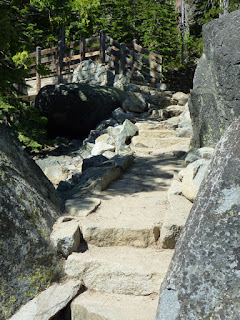The
Wilbur D. May Arboretum and Botanical Garden is a Washoe County
Regional Park in north Reno. This park is situated between the Sierra Nevada Mountains and the Great Basin Desert, southeast of Mt. Peavine: a transitional zone in a high desert environment with an arid climate. The arboretum and garden provides opportunities for education, research and for pleasure [1-3]. The nonprofit
May Arboretum Society organizes events and workshops.
The park is a mosaic of gardens and groves interconnected by a network of walkways and tiny trails. It includes a
Native Garden, a
Songbird Garden and a
Xeriscape to explore and showcase landscaping and gardening with no or little irrigation. Benches can be found in some hidden and shady areas. Informative panels have been placed at selected sites to introduce botanists, plants and historical subjects of local interest.
Getting there
The Wilbur D. May Arboretum and Botanical Garden belong to the
Wilbur D. May Center in
Rancho San Rafael Regional Park at 1595 North Sierra Street, Reno, Nevada. North Sierra St. is running parallel to North Virginia Street between Interstate 80 (Lincoln Highway) and North McCarran Blvd. From North Sierra St., turn west on Putnam Drive, which continues as San Rafael Drive. There is a parking area in front of the park and the
Wilbur D. May Museum. The park has various entrances, for example north of the museum, between the
Park Office and the
Arboretum Office as well as on the eastern side of the
Ranch House, from where a trail leads downhill to the riparian habitat along
Evans Creek and the
Arboretum Loop. Following Evans Creek in northwest direction you'll get to
Herman's Pond, on the left side of the trail. Uphill to your right is a gazebo and the Irwin Overlook. From the pond you may want to continue on to and through the McCarran underpass to get to the Basque Sheepherder Monument, the Ranch Disc Golf Course, the cottonwood grove
Nature Trail and many other hiking and mountain biking trails along creeks, canyons and across the Peavine foothills.
The public park is open from sunrise to sunset.
Keywords: park trails, botany, horticulture, high desert.
References and more to explore
[1]
Wilbur D. May Arboretum and Society, Reno, Nevada [
trailingahead.blogspot.com/2012/02/wilbur-d-may-arboretum-and-society-reno.html].
[2] Washoe County Nevada
> May Arboretum [
www.washoecounty.us/parks/arboretum/arbor.html].
[3] MuseumsUSA:
Wilbur D. May Arboretum and Botanical Garden [
www.museumsusa.org/museums/info/13252].
 Purple nama (Nama aretioides) is a small annual flowering plant growing on dry and sandy ground at low elevation in the Great Basin and other parts of the western United States. For example, in the Reno-Sparks area in northwest Nevada, the lower, south-facing slopes of Mount Peavine and the Hidden Valley Regional Park hillsides are good places to find patches of purple nama—usually flowering in May.
Purple nama (Nama aretioides) is a small annual flowering plant growing on dry and sandy ground at low elevation in the Great Basin and other parts of the western United States. For example, in the Reno-Sparks area in northwest Nevada, the lower, south-facing slopes of Mount Peavine and the Hidden Valley Regional Park hillsides are good places to find patches of purple nama—usually flowering in May.









